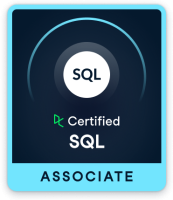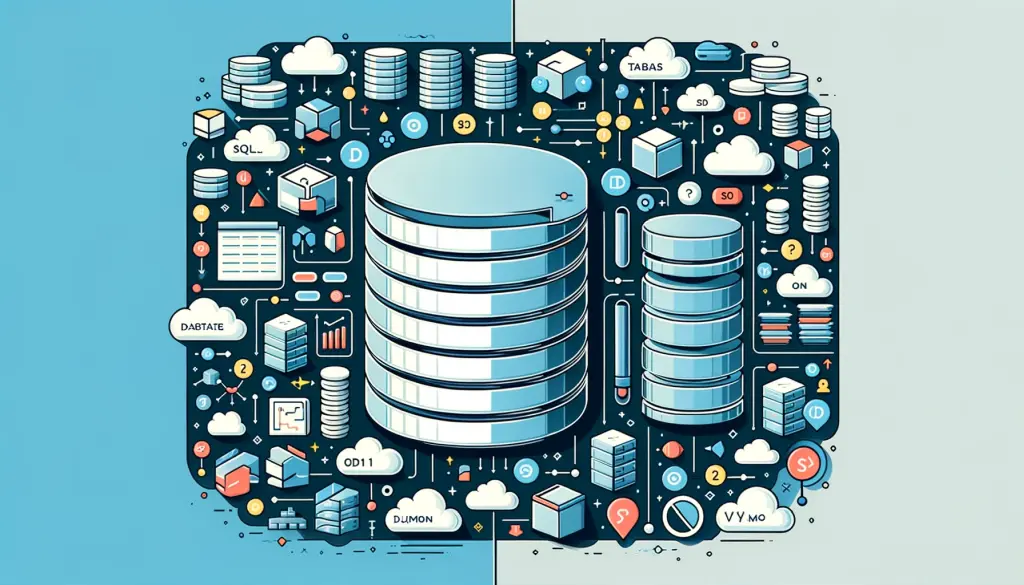SQL IS POWERFUL, VERSATILE, AND IN HIGH DEMAND
SQL is the most widely used database language. A good working knowledge of SQL is an important part of interacting with databases for developers, database administrators, web application designers, mobile app developers or a users of popular data reporting tools.
SQL is a necessary tool for data science. Virtually all data science work requires connection to and manipulation of databases. SQL is designed to make data management simple and efficient and is thus a necessary language for anyone looking to become Data Analyst or Data Engineer,
I am a certified DataCamp SQL Associate. As a SQL Associate I can demonstrate that I have the knowledge, skills, and abilities to succeed at the entry level in this role. The competency domains assessed included, but were not limited to:
- Data Management
- Exploratory Analysis
As a Data Analyst in SQL I can:
- write SQL queries,
- group and aggregate data to produce summary statistics,
- join tables and apply filters and sub-queries,
- write functions to explore and manipulate data,

Intro to SQL (Kaggle) 3 hours (skill track ⇒ certificate)
I learned SQL for working with databases, using Google BigQuery.
SQL Fundamentals (Datacamp) 22 hours (skill track ⇒ certificate)
In this track, I learned the skills I needed to level up my data skills and leave Excel behind me. Through hands-on exercises, I discovered how to quickly summarize, join tables, and use window functions and built-in PostgreSQL functions to analyze your data.
- Introduction to SQL (course ⇒ certificate)
I learned how to structure and query relational databases using SQL.
- Intermediate SQL (course ⇒ certificate)
I learned how to filter and compare data, how to use aggregate functions to summarize data, how to sort and group data, how to present data cleanly using tools such as rounding and aliasing.
- Joining Data in SQL (course ⇒ certificate)
In this course, I learned how to work with more than one table in SQL, use inner joins, outer joins and cross joins, leverage set theory, including unions, intersect, and except clauses, create nested queries.
- Data Manipulation in SQL (course ⇒ certificate)
I learned the robust use of CASE statements, subqueries, and window functions—all while discovering some interesting facts about soccer using the European Soccer Database.
- PostgreSQL Summary Stats and Window Functions (course ⇒ certificate)
I learned how to create queries for analytics and data engineering with window functions, the SQL secret weapon! Using flights data, I discovered how simple it is to use window functions, and how flexible and efficient they are.
- Functions for Manipulating Data in PostgreSQL (course ⇒ certificate)
I learned the most important PostgreSQL functions for manipulating, processing, and transforming data.
SQL Server Fundamentals (Datacamp) 22 hours (skill track ⇒ certificate)
In this track, I discovered how SQL Server is like a supercharged Microsoft Excel. Through interactive exercises, I learned how to access, query, and extract huge amounts of data from multiple databases. Using real-world data I also learned how to perform powerful cross-database analyses that I can then apply in my own role.
- Introduction to SQL Server (course ⇒ certificate)
I learned to use SQL Server to perform common data manipulation tasks and master common data manipulation tasks using this database system.
- Joining Data in SQL (course ⇒ certificate)
I learned how to join two or three tables together into one, combine tables using set theory, and work with subqueries in PostgreSQL.
- Intermediate SQL Server (course ⇒ certificate)
In this course, I used T-SQL, the flavor of SQL used in Microsoft’s SQL Server for data analysis.
- Time Series Analysis in SQL Server (course ⇒ certificate)
I learned how to build and work with dates, parse dates from strings (and deal with invalid strings), and format dates for reporting. I also saw how taking a different perspective on my data can solve difficult problems.
- Functions for Manipulating Data in SQL Server (course ⇒ certificate)
In this course, I learned how to make use of the most important functions for manipulating data provided by SQL Server. I used these functions for processing and transforming data to get the results you want.
SQL for Database Administrators (Datacamp) 16 hours (skill track ⇒ certificate)
In this track, I learned how to create, manage, and optimize PostgreSQL database. Through real-world exercises I writed and ran real-code in browser as I learn how to use T-SQL syntax, DML triggers, and improve query performance, making sure that the database can scale as your business needs grow.
- Introduction to Relational Databases in SQL (course ⇒ certificate)
I learned how to create tables and specify their relationships, as well as how to enforce data integrity. I also discovered other unique features of database systems, such as constraints.
- Database Design (course ⇒ certificate)
I learned how to process, store, and organize data in an efficient way. I learned how to structure data through normalization and present data with views. Finally, I learned how to manage the database and all of this did on a variety of datasets from book sales, car rentals, to music reviews.
- Creating PostgreSQL Databases (course ⇒ certificate)
This course teached me the skills and knowledge necessary to create and manage the PostgreSQL databases. Topics that covered included the structure of PostgreSQL databases, PostgreSQL datatypes, and normalization of databases to efficiently store data and avoid data loss. These topics were taught using data from the U.S. Small Business Administration (SBA).
- Improving Query Performance in PostgreSQL (course ⇒ certificate)
I learned how to structure the PostgreSQL to run in a fraction of the time. I learned the properties of a row oriented database.
SQL Server for Database Administrators (Datacamp) 24 hours (skill track ⇒ certificate)
In this track I learned the key skills you need to set-up, design, maintain, and monitor the team’s database.
- Introduction to Relational Databases in SQL (course ⇒ certificate)
I learned how to create tables and specify their relationships, as well as how to enforce data integrity. I also discovered other unique features of database systems, such as constraints.
- Database Design (course ⇒ certificate)
I learned how to process, store, and organize data in an efficient way. I learned how to structure data through normalization and present data with views. Finally, I learned how to manage the database and all of this did on a variety of datasets from book sales, car rentals, to music reviews.
- Transactions and Error Handling in SQL Server (course ⇒ certificate)
I learned how to handle errors and discovered how to manage transactions in case of an error. Additionally, I studied what happens when two or more people interact at the same time with the same data. I practiced all these concepts using two datasets, one of them based on bank accounts and the other one on an electric bike store.
- Writing Functions and Stored Procedures in SQL Server (course ⇒ certificate)
I learned the proper context for each modular programming tool and best practices. In the final chapter, I applied all of my new skills to solve a real-world business case identifying the New York City yellow taxi utilization for each borough, and which pickup locations should be scheduled for each driver shift.
- Building and Optimizing Triggers in SQL Server (course ⇒ certificate)
In this course I learned how to work with triggers and use them in real-life examples. Specifically, I learned about the use cases and limitations of triggers and get practice designing and implementing them. I also learned to optimize triggers to fit the specific needs.
- Improving Query Performance in SQL Server (course ⇒ certificate)
In this course I used SQL on real world datasets, from sports and geoscience, to look at good coding practices and different ways how we can can improve the performance of queries to achieve the same outcome.
SQL Server Developer (Datacamp) 41 hours (skill track ⇒ certificate)
I learned the basics of database design and the different SQL data types. In this track, I learned how to write queries, functions, and stored procedures. I also learned how to manage transactions, handle errors, and improve query performance.
- Introduction to SQL Server (course ⇒ certificate)
I learned to use SQL Server to perform common data manipulation tasks and master common data manipulation tasks using this database system.
- Introduction to Relational Databases in SQL (course ⇒ certificate)
I learned how to create tables and specify their relationships, as well as how to enforce data integrity. I also discovered other unique features of database systems, such as constraints.
- Intermediate SQL Server (course ⇒ certificate)
In this course, I used T-SQL, the flavor of SQL used in Microsoft’s SQL Server for data analysis.
- Time Series Analysis in SQL Server (course ⇒ certificate)
I learned how to build and work with dates, parse dates from strings (and deal with invalid strings), and format dates for reporting. I also saw how taking a different perspective on my data can solve difficult problems.
- Functions for Manipulating Data in SQL Server (course ⇒ certificate)
In this course, I learned how to make use of the most important functions for manipulating data provided by SQL Server. I used these functions for processing and transforming data to get the results you want.
- Database Design (course ⇒ certificate)
I learned how to process, store, and organize data in an efficient way. I learned how to structure data through normalization and present data with views. Finally, I learned how to manage the database and all of this did on a variety of datasets from book sales, car rentals, to music reviews.
- Transactions and Error Handling in SQL Server (course ⇒ certificate)
I learned how to handle errors and discovered how to manage transactions in case of an error. Additionally, I studied what happens when two or more people interact at the same time with the same data. I practiced all these concepts using two datasets, one of them based on bank accounts and the other one on an electric bike store.
- Writing Functions and Stored Procedures in SQL Server (course ⇒ certificate)
I learned the proper context for each modular programming tool and best practices. In the final chapter, I applied all of my new skills to solve a real-world business case identifying the New York City yellow taxi utilization for each borough, and which pickup locations should be scheduled for each driver shift.
- Building and Optimizing Triggers in SQL Server (course ⇒ certificate)
In this course I learned how to work with triggers and use them in real-life examples. Specifically, I learned about the use cases and limitations of triggers and get practice designing and implementing them. I also learned to optimize triggers to fit the specific needs.
- Improving Query Performance in SQL Server (course ⇒ certificate)
In this course I used SQL on real world datasets, from sports and geoscience, to look at good coding practices and different ways how we can can improve the performance of queries to achieve the same outcome.
SQL for Business Analysts (Datacamp) 20 hours (skill track ⇒ certificate)
In this track, I learned how to quickly explore and analyze data to make smarter business decisions. Through hands-on practice, I learned everything from creating and joining tables to writing queries, subqueries, and aggregate functions, providing me with the skills you need to excel and overcome real-world business challenges.
- Exploratory Data Analysis in SQL (course ⇒ certificate)
I used functions to aggregate, summarize, and analyze data without leaving the database. I learned common problems to look for and strategies to clean up messy data. I also learned how to exploring your own PostgreSQL databases and analyzing the data in them.
- Data Driven Decision Making in SQL (course ⇒ certificate)
In this course, I learned how to use SQL to support decision making. I learned to apply SQL queries to study for example customer preferences, customer engagement, and sales development. This course also covered SQL extensions for online analytical processing (OLAP), which makes it easier to obtain key insights from multidimensional aggregated data.
- Applying SQL to Real-World Problems (course ⇒ certificate)
In this course, I learned new skills that empowered me to find the tables I need. I learned how to store and manage this data in tables and views that I create. Best of all I also learned how to write code that not only clearly conveys my intent but is also legible.
- Analyzing Business Data in SQL (course ⇒ certificate)
In this course, I learned about the key metrics that businesses use to measure performance. I wrote SQL queries to calculate these metrics and produce report-ready results.
- Reporting in SQL (course ⇒ (certificate)
In this course, I applied all the SQL concepts and functions I have learned in previous courses to build out my very own dashboard.
Data Analyst in SQL (Datacamp) 39 hours (skill track ⇒ certificate)
I learned the fundamentals of database design and how to: write basic SQL queries, group and aggregate data to produce summary statistics, join tables and apply filters and sub-queries, write functions to explore and manipulate data.
- Understanding Data Visualization (course ⇒ certificate)
In this course I learned how to choose the best visualization for my dataset, and how to interpret common plot types like histograms, scatter plots, line plots and bar plots. I also learned about best practices for using colors and shapes in my plots, and how to avoid common pitfalls.
- Introduction to Statistics (course ⇒ certificate)
Statistics are all around us, from marketing to sales to healthcare. The ability to collect, analyze, and draw conclusions from data is not only extremely valuable, but it is also becoming commonplace to expect roles that are not traditionally analytical to understand the fundamental concepts of statistics.
- Introduction to SQL (course ⇒ certificate)
I learned how to structure and query relational databases using SQL.
- Intermediate SQL (course ⇒ certificate)
I learned how to filter and compare data, how to use aggregate functions to summarize data, how to sort and group data, how to present data cleanly using tools such as rounding and aliasing.
- Joining Data in SQL (course ⇒ certificate)
In this course, I learned how to work with more than one table in SQL, use inner joins, outer joins and cross joins, leverage set theory, including unions, intersect, and except clauses, create nested queries.
- Data Manipulation in SQL (course ⇒ certificate)
I learned the robust use of CASE statements, subqueries, and window functions—all while discovering some interesting facts about soccer using the European Soccer Database.
- PostgreSQL Summary Stats and Window Functions (course ⇒ certificate)
I learned how to create queries for analytics and data engineering with window functions, the SQL secret weapon! Using flights data, I discovered how simple it is to use window functions, and how flexible and efficient they are.
- Functions for Manipulating Data in PostgreSQL (course ⇒ certificate)
I learned the most important PostgreSQL functions for manipulating, processing, and transforming data.
- Exploratory Data Analysis in SQL (course ⇒ certificate)
I used functions to aggregate, summarize, and analyze data without leaving the database. I learned common problems to look for and strategies to clean up messy data. I also learned how to exploring your own PostgreSQL databases and analyzing the data in them.
- Data Driven Decision Making in SQL (course ⇒ certificate)
In this course, I learned how to use SQL to support decision making. I learned to apply SQL queries to study for example customer preferences, customer engagement, and sales development. This course also covered SQL extensions for online analytical processing (OLAP), which makes it easier to obtain key insights from multidimensional aggregated data.
- Data Communication Concepts (course ⇒ certificate)
In this course, I learned how to use storytelling to connect with my audience and help them understand the content of my presentation—so they can make the right decisions. I also learned the advantages and disadvantages of oral and written formats. I improved how I translate technical results into compelling stories, using the correct data, visualizations, and in-person presentation techniques.
My badges:
Some articles about Database
What is the difference between a relational database and a non-relational database?
A relational database and a non-relational database (often referred to as NoSQL database) are two different types of systems used to store […]
Unveiling the Role of a Data Engineer: Navigating the World of Databases
As a business analyst or data analyst, you’re well aware of the challenges that come with handling vast amounts of data. But […]
Unveiling the Power of MySQL: A Deep Dive into the World of RDBMS
MySQL, a robust relational database management system (RDBMS), stands as the cornerstone of data management in the tech industry. Widely acclaimed for […]




